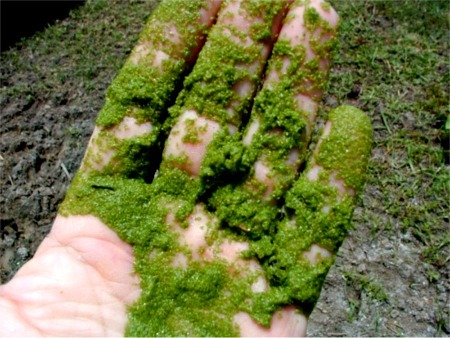- Elizabeth Larson
- Posted On
Water Resources offers guidance on avoiding algae problems

Last year, an outbreak of Lyngbya birgei resulted in serious issues for the lake, with the large, rotting mats keeping visitors away and causing alarm amongst residents, as Lake County News has reported.
Water Resources Program Coordinator Pamela Francis said some short-duration blooms have already occurred in the waters off of Clearlake and Clearlake Park, but the department has been monitoring the blooms.
To date, Francis said they haven't observed high quantities of Lyngbya birgei, the bottom-dwelling type of blue-green algae that created the problems last summer.
Nevertheless, officials are on the watch because of what Francis called “exceptional” water clarity, especially in the lake's upper arm.
That clarity, while considered by many to be a positive quality for the lake, is problematic because it gives algae the sunlight needed to grow, Francis explained.
“We certainly don't want it to happen like it did last year,” she said.
Since 1988, the county has only seen lyngbya four times, showing up for the first time in 1997, with instances also reported in 1998, 2001 and 2003, said Francis.
But she said those occurrences were orders of magnitude less than the 2009 outbreak.
In previous years, the cells per liter had measured between 100 and 100,000, said Francis.
“What we saw last year was millions of cells per liter in all arms” – the upper, Oaks and lower arms, according to Francis.
She said algae moves throughout the water column, and when it floats to the surface and is pushed by the wind, it can't go back down the water column as it normally would do.
When it stays on the surface, the sun hits it and it dies, which she said results in the kind of mats and stench that were reported last year.
Water Resources reported that there are four nuisance blue-green algae families in Clear Lake, which – with its watershed, relatively shallow depth and warm climate – is an ideal environment for the algae growth.
Clear Lake is a eutrophic lake – meaning it's rich in the kind of nutrients that feed algae that can become a nuisance when they form mats and die, according to a Water Resources report.
Francis said there are things county residents can do to help mitigate algae growth and prevent it from becoming a nuisance.
That includes keeping algae alive and moving it through its natural daily cycle of rising and falling, and breaking up mats that begin to form by using boats and spray systems, said Francis, who compared it to pool maintenance.
She said the county has a volunteer network, along with pontoon boats purchased last year, to help prevent algae nuisance issues.
Water Resources' tips to keep algae problems from developing begin with being proactive, and not waiting for algae build up.
To dissipate algae slicks, agitate the water daily through spray systems, which can be installed along the shoreline and on docks and piers. Such a system requires a pump, pipe and nozzles that spray the algae with water to sink it. For plans and part lists, see the Water Resources Web site at www.co.lake.ca.us/Government/Directory/Water_Resources.htm.
Officials also suggested that garden hoses can be used, but people are urged to avoid using treated drinking water if possible. Instead, use irrigation pumps drawing from the lake with screens protecting the water intake.
In places where algae has built up, boats and jet skis can be used to dissipate the algae into the water column, according to Water Resources.
For more information call the Lake County Water Resources Department, 707-263-2344.
E-mail Elizabeth Larson at This email address is being protected from spambots. You need JavaScript enabled to view it. . Follow Lake County News on Twitter at http://twitter.com/LakeCoNews and on Facebook at http://www.facebook.com/pages/Lake-County-News/143156775604?ref=mf .










